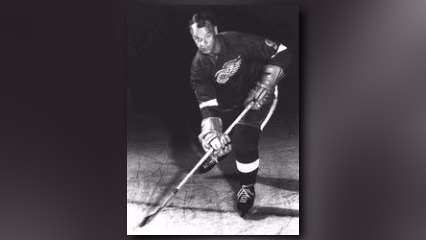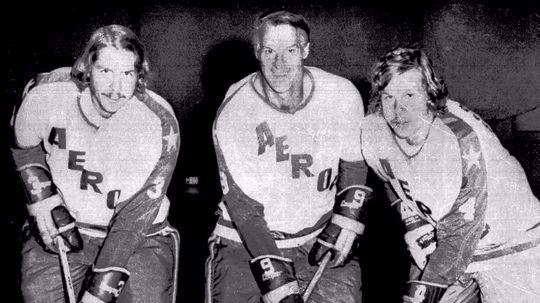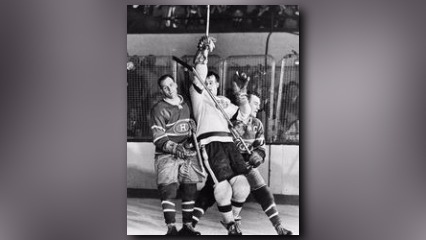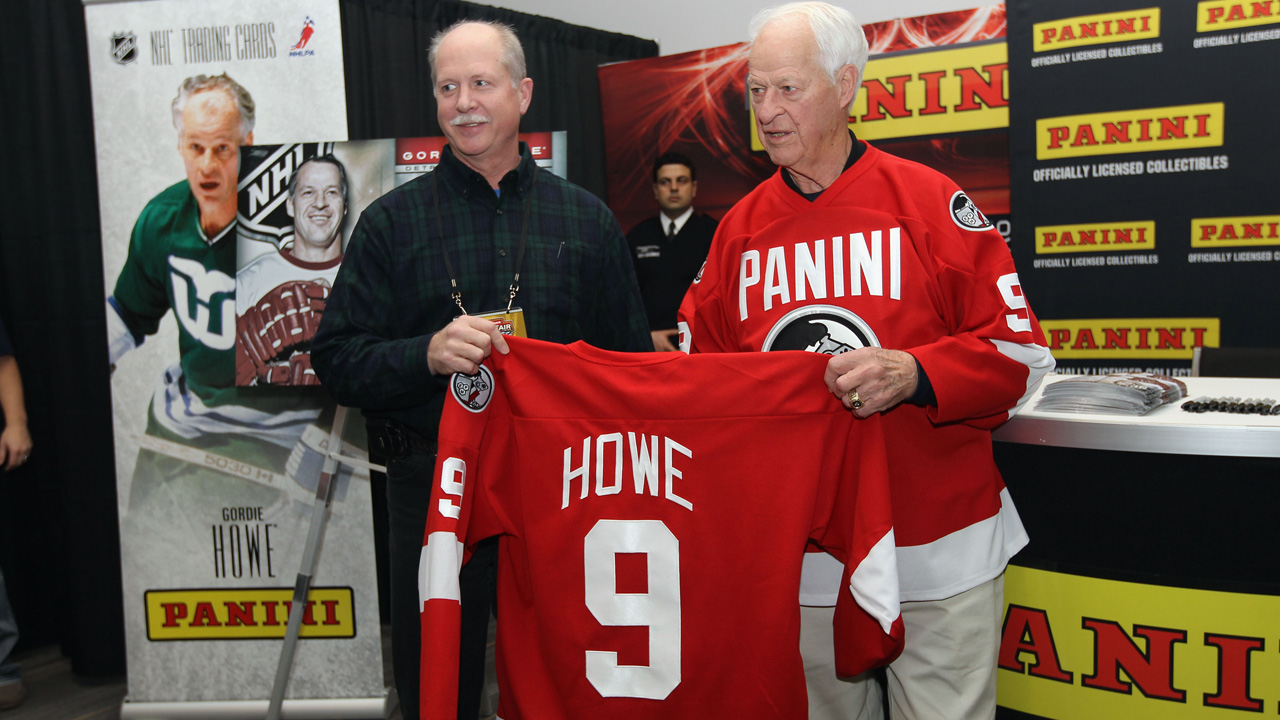Gordie Howe, considered one of the NHL's greatest players and ambassadors, died Friday at 88.
His nickname says it all: Mr. Hockey," said Calgary Flames president of hockey operations Brian Burke. "His impact and legacy are both as broad as his shoulders."

Howe, who turned 88 in March, had been diagnosed with dementia in 2012. He had previously taken care of his wife, Colleen, until she died from complications of Pick's Disease, a form of dementia, in 2009.
During Howe's peak years in the 1950s and 1960s, he seemed more popular than his sport. Howe was often featured in newsreels. The late Detroit Red Wings general manager Jack Adams called Howe "the Babe Ruth of hockey." His fame stretched beyond the confines of the sports pages. His exploits were written about in Look magazine.

Famed NBC broadcaster Mike Emrick said Howe did as much for the NHL as an ambassador as he did on the ice, where he was the second-leading goal scorer in league history.
"What he did for the sport in the U.S. - during its several eras of growth - was to epitomize the humility and friendliness of hockey athletes." Emrick said. "People came up to Gordie Howe because they knew they could. And they would walk away with a smile on their face, just like they expected to."
According to legendary coach Scotty Bowman, those who played against Howe "thought he was close to Superman."

Former NHL and World Hockey Association coach Harry Neale has long said that Howe is the best all-around player in NHL history. Howe played his first game in the NHL for the Detroit Red Wings in 1946 at age 18, and played his last game for the Hartford Whalers at age 52 in 1980.
"He has been omnipresent forever," said former NHL player Ray Ferraro in a recent radio interview.
Counting his time in both the NHL and World Hockey Association, Howe played 32 pro seasons.
"If you equate greatness with superior play and durability, there is no match for Gordie Howe — I don't even think there is a challenger," Neale once told USA TODAY Sports.
He was born and raised in Saskatchewan, where he once was banned from playing forward and defense in elementary school hockey because he was too talented. He only was allowed to play as a goaltender.
"His roots and the roots of the game were the same: rural Canada," Emrick said.

In an era when 20 goals confirmed a player was near the head of his class, Howe scored at least 23 for 22 consecutive NHL seasons and the next five in the WHA. He won the scoring title six times and won the Hart Trophy as the NHL's Most Valuable Player six times.
"When I think about players, I consider three ingredients: the head, heart and the feet," Bowman has said. "Some players don't have any of those, and some players have one or two. But Gordie had all three in high dimensions."
Howe played with left wing Ted Lindsay and center Sid Abel on the famed Production Line. The name was chosen to salute fact that the three players played in a team famous for automobile assembly lines. Coach Tommy Ivan put the Red Wings trio together in 1947 when Howe was 19. In 1949-50, Lindsay, Abel and Howe finished first, second and third in the NHL scoring race and the Red Wings won the Stanley Cup championship.
The following season, Howe started a run of four consecutive NHL scoring championships.
"I always said that being with Teddy helped (Howe) become a better hockey player," said their former Red Wings teammate Marty Pavelich. "Teddy was so aggressive that I think that Gordie got caught up in that, too."
Howe scored 801 goals in the NHL, second only to Wayne Gretzky's 894, and another 174 in the WHA. Counting his regular-season and playoff goals in both leagues, Howe totaled 1,071.
And Howe did it all seemingly effortlessly.
"It is like a great golfer," Hall of Fame hockey coach Al Arbour said. "They swing so nice and easy and they make it seem so simple. You try to duplicate that swing and it's impossible.
"No one could do it like Mr. Hockey. No matter what it was, he could do it well, whether it was penalty killing, power play or making passes."
Howe was a right-hand shot, and yet he sometimes would shoot left-handed just to confuse the goalie.
"He probably got 50 or 60 goals in his career like that," former NHL goalie Eddie Johnston said. "A puck would be in his skates and he would kick it to the wrong side. Then he would shoot left-handed and catch you by surprise."
Hall of Fame player Bill Gadsby, who was Howe's close friend, has often said he would be amused when he read or heard it suggested that Howe wasn't fast.
"I watched a lot of good skaters try to catch him from behind and never do it," Gadsby said.
Arbour said when a defender came close to catching Howe, "he would put it into the next gear."
'Meanest, nastiest' on skates
But there was a flip side, too.
While Howe seemed to have more skill than anyone, he also would use his brute strength as an effective weapon.
"He was a bull," Johnston once told USA TODAY Sports. "If there was no room, he would jam on you. He would drive you and the puck into the net."
Howe stood only 6 feet tall and weighed a little more than 200 pounds. Even so, he was so physically intimidating that he seemed monstrous to his opponents.
"He looked six-foot-eight," Hall of Fame goalie Glenn Hall said. "We thought he should have been playing basketball."
Howe was known as a ruthless competitor, a man who didn't use his stick simply to score goals.
"(Howe) was a miserable guy to play against," said Neale, who coached Howe in Hartford. "He had no conscience when he hit you with his stick. Players didn't touch him very often."
Howe had a knack for sending an opponent flying without the victim knowing exactly what had happened to him.
"He lived up to his reputation of Mr. Elbows," former NHL player Ralph Backstrom said in a 2004 interview.
In 1959, Howe beat up Lou Fontinato in one of the most famous fights in NHL history. Howe was the MVP of the league that season and Fontinato was supposed to be the toughest fighter in the league.
When Howe felt wronged, there was no statute of limitations on his vengeance. In 1959, then-Toronto Maple Leafs defenseman Bobby Baun knocked Howe senseless with a bodycheck.
in 1967-68, so the story goes, Baun was playing for the Oakland Seals when he saw Howe in a vulnerable position. But this time, just as Baun was about to strike, Howe whacked Baun in the throat with his stick.
"Baun told me he was lying on the ice. ... He couldn't breathe. He couldn't talk," Neale said. "There was Gordie coasting over to him. He looked down and said, 'Now we are even."
Neale laughed. "He waited eight years."
During the 1950 playoffs, Howe suffered a near-fatal brain injury after a collision with Toronto Maple Leafs forward Teeder Kennedy.
What actually happened has been the subject of debate for many years, but Howe's brother, Vic, was in the stands and he said Kennedy's stick caught Howe above the eye as Howe was coming at him. Howe's helmetless head struck the ice when he went down.
Vic Howe said in a 2004 interview that he went to see Gordie after the period and was told that Howe just needed stitches.
"But when I went down after the game, trainer Lefty Wilson had a different expression," Vic Howe said.
Wilson told Vic that his brother was being rushed the hospital. During the night, surgeons had to drill a hole in Howe's skull to relieve the pressure. The story that came out over the next couple of days was that Howe had nearly died.
He didn't play for the rest of the playoffs, but he was ready to play the following season.
After Sid Abel was traded to the Chicago Blackhawks in 1952, Alex Delvecchio became the Production Line center. The line continued to have success.
"Ted and I played together so long that we could anticipate each other's moves," Howe once said.
Legendary ambassador for the game
Howe's blend of durability and longevity is unmatched in NHL history. n 26 NHL seasons, he played 97% of all of his team's games. From 1961 to 1970, he missed only two games.
He registered his first 100-point season for the Red Wings when he was 40. At 50, he scored 34 goals for the New England Whalers. in 1977-78. At 52, he scored 16 goals in his final NHL season.
"I would not seriously try to convince anyone that Wayne Gretzky, Bobby Orr or Mario Lemieux wasn't as good as Gordie, because that is an argument that will go on forever," Neale said. "All I know is that I had Gordie when he was 49 and 50, and he was still a phenomenal athlete. ... His passion for the game was unequaled."
The reason why Howe jumped to the WHA was for a chance to play on a professional team with two sons, Mark and Marty. They played together for the Houston Aeros and New England Whalers.
Gordie Howe was known for looking out for his sons. Mark Howe has said through the years that the force of Gordie coming after someone who checked his son hurt more than the initial check.
"The second after I would get hit there would be a much bigger thud," Mark Howe said. "Finally, I had to say to him, 'Dad, I can take a hit from anybody. But you are killing me by hitting the guy who hits me."
Howe has long had a reputation as one of the NHL's top ambassadors. Mark Howe has often told the story of how he was able to hone his hockey skills by playing ball hockey after every Detroit home game, because he knew his father would always spend an hour signing autographs for every person who waited.
In 2004, rival Bobby Hull said about Howe: "When everything is gone by the wayside, the only thing that remains is character -- and Gordie Howe has character."
Gordon "Gordie" Howe
- Born: March 31, 1928, in Floral, Saskatchewan, Canada
- Nickname: Mr. Hockey
- Education: Attended but did not graduate from King George Community (High) School in Saskatoon
- Hall of Fame: Inducted in 1972 into the Hockey Hall of Fame; member of 11 halls of fame
- Playing career: 1946-71 with the Detroit Red Wings; 1973-77 with the World Hockey Association's Houston Aeros; 1977-79 with the WHA's New England Whalers; 1979-80 with the NHL's Hartford Whalers. The right wing was a 21-time NHL All-Star, 12 times to the first team; six-time NHL scoring leader and six-time league MVP; played on four Stanley Cup champion teams with the Detroit Red Wings; oldest to play in an NHL game (52 years, 10 days)
- Foundation: The Howe Foundation, founded by his late wife Colleen "to help those in need and allow them to be able to enjoy, participate and learn about the great sport of hockey."
- Author: Gordie Howe: My Hockey Memories (with Frank Condron), 1999; and ... Howe!: An Authorized Autobiography (with Colleen Howe, Tom Delisle), 1995; Let's play Hockey, 1972
- TV series: Himself on Yes, Dear (2004) and E.N.G. (1993)
- Trivia: "Mr. Hockey" and "Mrs. Hockey," for his wife, became registered trademarks
- Quote:"No, but 11 other guys did." -- Howe, asked if he ever had broken his nose


